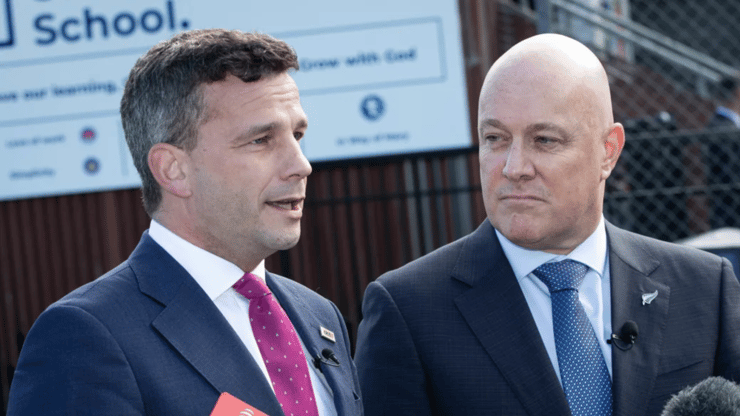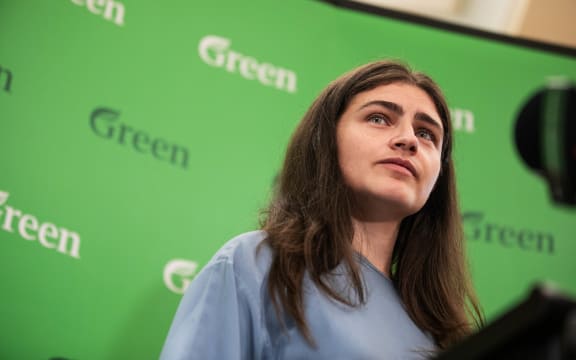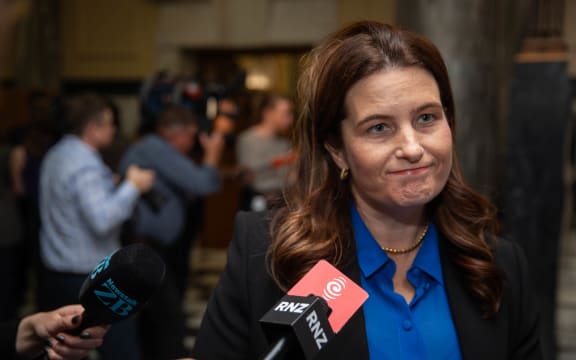The Week In Politics: Targets, Truants & MPs' Pay Pickle

Analysis: The government sets "ambitious" public service targets and promises quarterly progress reports, David Seymour sets out his truancy strategy and the next political hot potato - will MPs accept pay rises?
The government on Monday released nine public service targets, and the opposition reaction was, "Where's the plan?"
The targets included shorter waiting times for healthcare, reduced youth offending, reduced violent crime, fewer people on the Jobseeker benefit, increased school attendance, better exam results, fewer people in emergency housing and reduced greenhouse gas emissions.
The most publicised were 50,000 fewer people on Jobseeker Support and a 75 percent reduction in the number of families in emergency housing.
The deadline has been set at 2030 - two elections from now - and the government bravely promised there would be quarterly progress reports, starting in the middle of this year.
Labour and the Greens will eagerly await them, and any failure to show results will be blamed squarely on ministers.
On the other side of that, progress will mean the government can show it really is "getting things done" and improving public service outcomes.
Prime Minister Christopher Luxon called the targets "ambitious" and said they wouldn't be easy to achieve.
"But we're not here to do what is easy - we're here to do what is needed… enough if enough, the excuses have to stop."
Labour's angle of attack was that there were no indications of how the targets would be achieved. Finance spokesperson Barbara Edwards said with public sector cuts going on, public servants were being set up to fail, RNZ reported.
"Who's going to do the work?" she asked. "Just because you have a target doesn't necessarily mean that the work is being resourced."
Green Party co-leader Chlöe Swarbrick was scathing.
"These nine targets come without a whiff of a plan and are deliberately geared to punish," she said. "He's talking about kicking people out of emergency housing and off of welfare instead of genuinely ambitious goals to support meaningful contributions in communities to improve housing security."

Chlöe Swarbrick. Photo: RNZ / Samuel Rillstone
It's not the first time targets have been set - the previous National-led government set them in 2012 and refined them in 2017.
Labour scrapped them, and one of the reasons it gave was that they distracted attention from non-target areas. It gave as an example hospitals throwing resources at emergency department waiting times at the expense of other care fields.
Victoria University emeritus professor of public policy Jonathan Boston said there were merits and risks involved. They set expectations and sent signals to the public sector, and most targets did achieve better outcomes, he told RNZ.
But they could also mean less focus or a deterioration in other areas, particularly where improvements were harder to measure or took longer to achieve.
"Organisations, understandably, focus on the things that are deemed to be important to decision-makers - the ministers in this case - and therefore things tend to get de-emphasised."
Traffic lights for truants
That was the government's first policy hit of the week and the second soon followed.
ACT leader and associate education minister David Seymour revealed his plan to raise the level of school attendance.
There would be a traffic light system with "clear obligations" for students not attending school, along with increased data reporting, he said.
There would be a public communications campaign about the importance of education, public health guidance about when a student was well enough to attend school, and attendance would be set as a strategic priority for school boards.
The policies aren't fully formed, with decisions on daily reporting, the traffic light system and the strategic priority for school boards not yet taken to Cabinet, RNZ reported.
Seymour's idea is to ramp up to daily attendance reporting by schools so it's treated like a crisis, in the same way daily case numbers were used during the Covid-19 pandemic.
It will start with weekly attendance numbers from the second week of term two.
Data is currently collated over a school term but there's a months-long lag between the end of term and the publication of the full data set, RNZ's report said.
The issue of how ill pupils should be before parents decide to keep them home is a difficult one for the government, and Seymour explained how it would be handled.
"Something on a par with what they have in the UK where they give parents a clear decision tree of: if your kid has this symptom, you need to either keep them home from school, see a doctor, or get more information," he said.
"Or in some cases it may actually be acceptable to go to school - not every ailment means that you should not attend school."
Seymour told Checkpoint attendance rates had fallen from 69.5 percent in 2015 to 39.9 percent in 2022. He pointed to attendance rates of 75.1 percent in England, 70.3 percent in the US and 49.9 percent in Australia.
Luxon joined Seymour at the announcement and said 54 percent of children were not regularly attending school, which meant that by the time they were 15 they would have lost a year's worth of education.
"The numbers are shameful - there's no other way to describe it," he said.
These policy initiatives were positive for the government and the targets in particular are likely to be popular with the public, so why should Labour be negative?
The Herald's Audrey Young thought it was making a mistake.
"Labour's constant opposition to targets is plain dumb and erodes its credibility," she said.
"It is an example of what it said it would not do - bark at every passing car. Few people would argue there is something inherently wrong in setting a target… it would be in Labour's interests to leave the opposition to such reasonable policy to the Greens."
Young said Labour needed to learn when it was better to say nothing - "and that should be on policies for which there is likely to have popular support and for which there is no disagreement in principle".
MPs' pay pickle
In about two weeks the independent Remuneration Authority will release its recommendations on MPs pay, and as they haven't had an increase for a few years it's expected to say they should get one.
Neither Luxon nor Labour leader Chris Hipkins wanted to talk about what's going to be a prickly problem. Their attitude was that the authority is independent, it was deliberately set up that way, and it should be allowed to do its job.

Nicola Willis. Photo: RNZ / Angus Dreaver
"It's not for a prime minister or an MP to comment on their pay… I am not involved with that and I don't want to be involved with that," RNZ quoted Luxon as saying.
Hipkins was just as cautious, saying it was a difficult time for the authority to be potentially recommending pay rises for MPs given the economic conditions.
"I do think the Remuneration Authority making those decisions will need to weigh up the broader environment when they do that."
They're not going to get away with those bland responses for long, because when the authority releases its recommendations they're going to have to say whether they'll accept a pay rise.
Finance Minister Nicola Willis showed her political radar was in good running order when she was asked what her attitude was. "I don't want one," she told media.
And on Newstalk ZB she went further: "I think it would be very fair to say I would be very uncomfortable if I got offered a big pay rise right now. That would make me really, really, really uncomfortable."
It's not difficult to imagine the public reaction if MPs accepted a hefty pay rise.
"At a time of a cost of living crisis it would be deeply unpopular and will lead to a backlash," said commentator Bryce Edwards, in an article by Jason Walls in the Herald.
He doubted whether Parliamentarians would even want a pay rise.
"Despite this, it's understood some MPs are not unsympathetic to the idea of a pay rise," Walls said. "That's because it's been six-and-a-half-years since they last received a bump in their pay packet."
In 2018, the then Prime Minister Jacinda Ardern instituted a pay freeze for all MPs after the authority recommended a 3 percent pay raise. The recommendation came at a time of widespread teacher and nurses strikes.
"It does not sit well with me or the government that… we have increases that are out of kilter with what the average New Zealander is seeing," Ardern said at the time.
Walls' article quoted a spokesman for the authority as saying it implemented a zero increase from 1 July, 2019 until after the election in October 2020. When it carried out a review after that election, the pandemic was in full flight so it again came out with a zero increase. Now it is back on the agenda.
"We are starting again and investigating what fair relativity is at this time for for MPs' pay - that is effectively what the law requires us to do," the spokesman said.
Walls' article explained the sliding pay scale for MPs, from the prime minister's $471,049 a year down to MPs with no leadership positions in their party, on $163,961 a year.
Edwards said the current review brought into focus the issue of politicians' pay in general.
"In the past, the average backbench MP received a pay that was roughly in line with a senior secondary school teacher; these days it's roughly double that," he said.
"If the way our representatives live and the incomes they're used to are so out of sync with wider society, it will make people wonder whether they are representatives or part of a distanced elite."
Slide in polls
The latest poll could be on the government's mind when crunch time comes for decisions on MPs pay. The Taxpayers Union-Curia poll showed all three coalition parties had lost support and all three opposition parties had gained, RNZ reported.
National was down 0.3 points to 37.1 percent, ACT was down 2.8 points to 7.2 percent and NZ First was down 1.1 points to 6.3 percent. Labour was up 0.4 points to 25.7 percent, the Greens were up 3.3 points to 14.6 percent and Te Pāti Māori was up 2.1 points to 4.6 percent.
The changes in main party support were less than a percentage point and well within the margin of error (+/- 3.1 percent).
The results won't worry the coalition parties - they knew they were going to have to ride out a difficult time with public service job cuts. What's eventually going to worry them, a lot, will be voter reaction if there's no gain from all the pain.
*Peter Wilson is a life member of Parliament's press gallery, 22 years as NZPA's political editor and seven as Parliamentary bureau chief for NZ Newswire.





